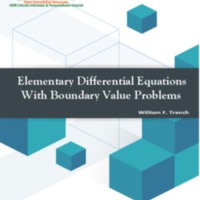Elementary Differential Equations with Boundary Value Problems
Dublin Core
Subject
Description
Elementary Differential Equations with Boundary Value Problems is written for students in science, engineering, and mathematics who have completed calculus through partial differentiation.
An elementary text should be written so the student can read it with comprehension without too much pain. I have tried to put myself in the student’s place, and have chosen to err on the side of too much detail rather than not enough.
An elementary text can’t be better than its exercises. This text includes 1695 numbered exercises, many with several parts. They range in difficulty from routine to very challenging.
An elementary text should be written in an informal but mathematically accurate way, illustrated by appropriate graphics. I have tried to formulate mathematical concepts succinctly in language that students can understand. I have minimized the number of explicitly stated theorems and definitions, preferring to deal with concepts in a more conversational way, copiously illustrated by 250 completely worked out examples. Where appropriate, concepts and results are depicted in 144 figures.
Although I believe that the computer is an immensely valuable tool for learning, doing, and writing mathematics, the selection and treatment of topics in this text reflects my pedagogical orientation along traditional lines. However, I have incorporated what I believe to be the best use of modern technology, so you can select the level of technology that you want to include in your course. The text includes 336 exercises – identified by the symbols C and C/G – that call for graphics or computation and graphics. There are also 73 laboratory exercises – identified by L – that require extensive use of technology. In addition, several sections include informal advice on the use of technology. If you prefer not to emphasize technology, simply ignore these exercises and the advice.
An elementary text should be written so the student can read it with comprehension without too much pain. I have tried to put myself in the student’s place, and have chosen to err on the side of too much detail rather than not enough.
An elementary text can’t be better than its exercises. This text includes 1695 numbered exercises, many with several parts. They range in difficulty from routine to very challenging.
An elementary text should be written in an informal but mathematically accurate way, illustrated by appropriate graphics. I have tried to formulate mathematical concepts succinctly in language that students can understand. I have minimized the number of explicitly stated theorems and definitions, preferring to deal with concepts in a more conversational way, copiously illustrated by 250 completely worked out examples. Where appropriate, concepts and results are depicted in 144 figures.
Although I believe that the computer is an immensely valuable tool for learning, doing, and writing mathematics, the selection and treatment of topics in this text reflects my pedagogical orientation along traditional lines. However, I have incorporated what I believe to be the best use of modern technology, so you can select the level of technology that you want to include in your course. The text includes 336 exercises – identified by the symbols C and C/G – that call for graphics or computation and graphics. There are also 73 laboratory exercises – identified by L – that require extensive use of technology. In addition, several sections include informal advice on the use of technology. If you prefer not to emphasize technology, simply ignore these exercises and the advice.
Creator
Publisher
Contributor
Cut Rita Zahara
Rights
Creative Commmons
Type
Files
Collection
Citation
William Trench, “Elementary Differential Equations with Boundary Value Problems,” Open Educational Resources (OER) , accessed December 14, 2025, https://oer.uinsyahada.ac.id/items/show/814.


